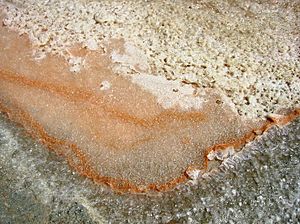Dunaliella salina facts for kids
Quick facts for kids Dunaliella salina |
|
|---|---|
 |
|
| Pink Dunaliella salina in sea salt | |
| Scientific classification | |
| Kingdom: | |
| Phylum: | |
| Class: |
Chlorophyceae
|
| Order: |
Volvocales
|
| Family: |
Dunaliellaceae
|
| Genus: |
Dunaliella
|
| Species: |
D. salina
|
| Binomial name | |
| Dunaliella salina |
|
Dunaliella salina is a tiny, pink-colored algae that lives in very salty places. You can often find it in sea salt fields, which are areas where salt is collected from ocean water. This special algae is used in things like cosmetics (makeup and skin products) and dietary supplements (vitamins and health products).
Not many living things can survive in super salty places, like the salt ponds where Dunaliella salina thrives. To stay alive, this algae has some amazing tricks! It makes a lot of beta-carotene, which is a reddish-orange color. This beta-carotene helps protect the algae from too much sunlight. It also produces a lot of glycerol, which is a type of sugar alcohol. Glycerol helps the algae deal with osmotic pressure, which is the way water moves in and out of cells. This means the algae can keep its cells healthy even in very salty water. Because Dunaliella salina makes these useful substances, people can grow it to produce them for commercial use.
Contents
What is Dunaliella salina?
Dunaliella salina is a type of micro-algae. This means it is a very small plant-like organism that you can only see with a microscope. It belongs to a group called halophiles. A halophile is any organism that loves and can live in extremely salty environments. These places include salt lakes, salt ponds, and even salty soil.
Why is it pink?
The pink or reddish color of Dunaliella salina comes from the high amount of beta-carotene it produces. Beta-carotene is a pigment, which is a natural coloring substance. It's the same pigment that makes carrots orange! The algae makes more beta-carotene when it is exposed to bright sunlight and very salty conditions. This pigment acts like a natural sunscreen, protecting the algae from harmful UV rays.
Where does it live?
Dunaliella salina is found all over the world in places with high salt concentrations. These include:
- Salt ponds: These are shallow pools where seawater is left to evaporate, leaving behind salt.
- Salt lakes: Many salt lakes, like the Great Salt Lake in the United States or Lake Retba in Senegal, are home to this algae.
- Coastal lagoons: These are shallow bodies of water near the sea that can become very salty.
Surviving in salt
Living in extremely salty water is tough for most organisms. When water is very salty, it tries to pull water out of living cells. This is called osmotic pressure. If a cell loses too much water, it can dry out and die. Dunaliella salina has special ways to prevent this. It produces a lot of glycerol inside its cells. This glycerol helps balance the saltiness outside the cell, so the algae does not lose too much water.
Uses of Dunaliella salina
Because Dunaliella salina produces so much beta-carotene and glycerol, it is grown for many different uses.
In health and beauty
- Dietary supplements: Beta-carotene is a type of antioxidant. Antioxidants help protect your body's cells from damage. When you eat beta-carotene, your body can turn it into Vitamin A, which is important for good vision and a healthy immune system.
- Cosmetics: The beta-carotene from Dunaliella salina is used in some skin care products. It can help protect the skin from sun damage and give it a healthy glow. Glycerol is also used in cosmetics as a moisturizer, helping to keep skin hydrated.
Other uses
- Food coloring: The natural pink or orange color from the algae can be used as a natural food coloring.
- Animal feed: Sometimes, the algae is added to animal feed to improve the health and color of farmed animals. For example, it can make salmon meat look more pink.
Images for kids
-
Salt ponds in San Francisco Bay
-
Dunaliella salina orange-colored water of the salt lake Sivash, Crimea
-
Dunaliella salina, tentatively identified from the hypersaline Lake Tyrrell, Victoria, Australia. Alongside are small haloarchaeons, Haloquadratum walsbyi, with their flat square-shaped cells.
See also





